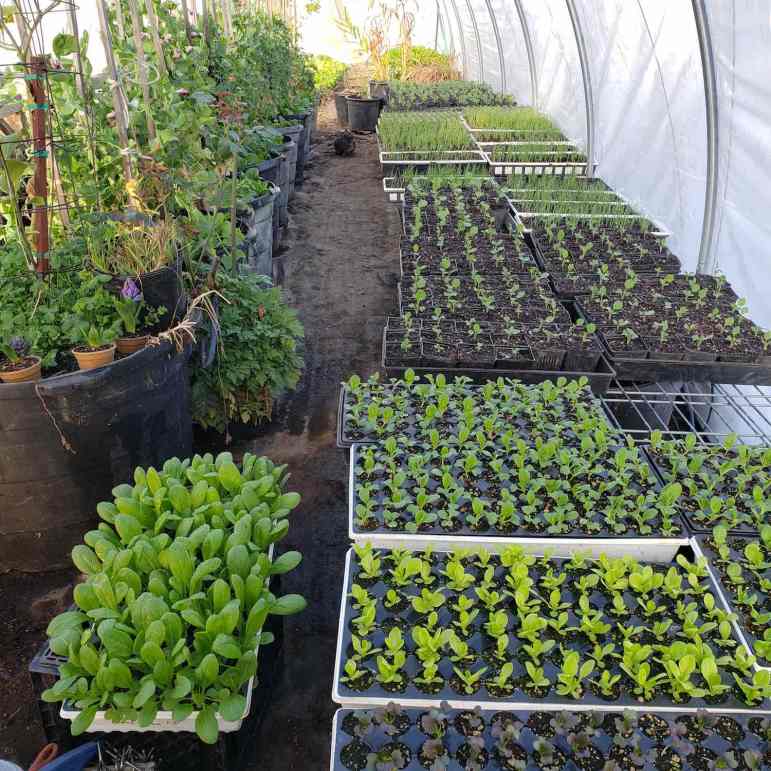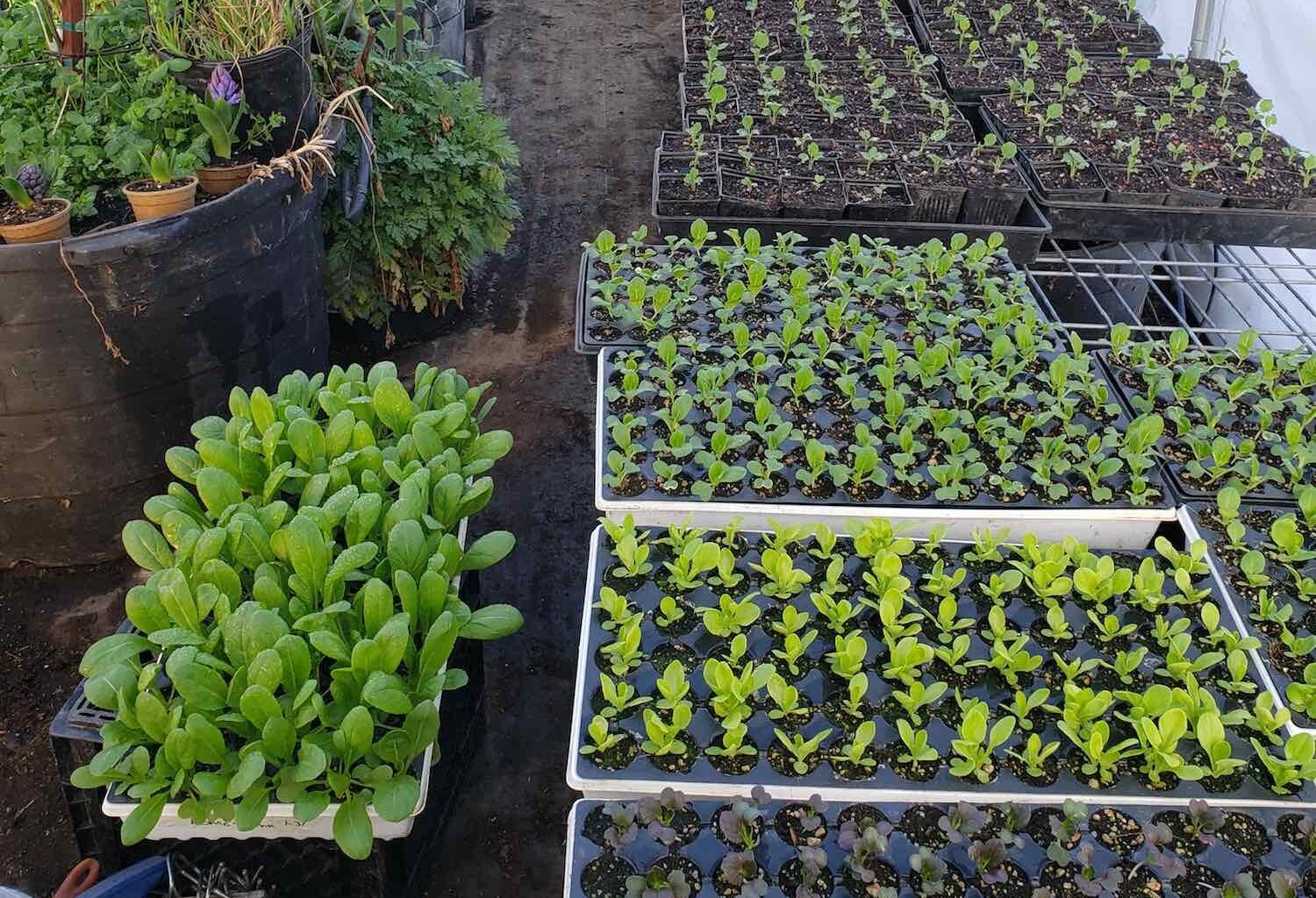 (Illustration by Joe Dworetzky/Bay City News)
(Illustration by Joe Dworetzky/Bay City News)
Casey O’Neill is a farmer and owner of Happy Day Farms in Laytonville, Calif. The opinions expressed in this column are not those expressed by The Mendocino Voice.
At night when I lie awake in my bed, visions of plant beds dance in my head. Plantings and spacings are puzzles galore, thousands are planted, and I’ll sow many more. Seeds by the dozens, hundreds and scores, big seeds, little seeds, 72 cells trays and 264s.
Planning is tricky because there are so many variables. Different crops have different growth times, which also change over the course of the year with the day length and strength of the sun. Everything grows faster around the full moon, slower during the new moon. Hotter weather makes for rapid growth, cool spells slow things down.
Sowing seeds an average of every 10 days makes for consistent trays of starts coming out of the propagation house. If I maintain the cadence of seed-starting, then the downstream pieces must flow accordingly; I have to clear and prep enough beds to accommodate the plants waiting to go out. The bigger the pot size, the more flexibility and forgiveness there is for timeline delays. Four-inch pots hold a long time, while the 264-cell Paperpot trays are a matter of a few days before stunting starts.
I’m trying to get the scheduling down so that we sow seeds on the 10th, 20th and 30th days of each month. Working towards clear routines is a core part of my strategy for a functional farm that doesn’t overwork us, and we’re doing better at it this year than ever before. The season is still young, yet I’m almost at full production at my place, with only two beds untouched, two under covers awaiting planting and two ready for planting tomorrow.
 Trays of starts at HappyDay Farms in Laytonville, Calif. (HappyDay Farms via Bay City News)
Trays of starts at HappyDay Farms in Laytonville, Calif. (HappyDay Farms via Bay City News)
When I sow I do the same core crops each cycle. In the four-inch Paperpots I do three trays of Asian greens salad mix, one tray of Hakurei salad turnips, two trays of rotating red choy, tatsoi, arugula and mizuna, and two trays of lettuce mix. In the six-inch Paperpots I sow two trays of salanova lettuce, and two trays of rotating kale, collards and bok choy. I use the two-inch Paperpots to sow four trays of beets and four trays of scallions.
Six-inch Paperpots at 264 cells yield three passes on a 50-foot bed, four-inch is two passes and two-inch is one pass. At six rows to a bed, I can plant two trays of Salanova, or two trays of bok choy/collards/kale. Four-inch greens are three trays to a bed, and two-inch I can fit as many as six trays. It would be nice if all my beds were standardized, but some are 30 inches and some are 42 inches in width, with varying lengths from 50 to 80 feet. The lack of standardization confounds the planting variables.
I used to try and plan everything out, marking the beds and my expected rotations, but it quickly goes to hell because many of the crops are on such quick rotations that a week or two error in timeline adds up quickly to make the planning document worthless. Now, I plan my large crops; I know where tomatoes, peppers, cannabis, squash and brassica go. Then I use the open bed spaces to fill whatever is ready coming out of the propagation house.
All six of my cannabis terraces are planted to successions of lettuce, bok choy, beets, scallions and Asian greens. As planting happens over the next few months, I’ll lose those beds for vegetables and will find myself in a space crunch. This year I’m phasing out winter squash production, and am planning to use the seven beds that are planted to heading brassica (cauliflower, cabbage, broccoli, romanesco) for a summer planting window of the quick rotation crops.
As we edge towards fall, cannabis will start coming out, and I’ll utilize the spaces to fill back in with vegetables, starting with the light dep tunnels in late September. This year my plan is to use my cannabis beds for late fall brassica so that I can maintain the other spaces for the quick rotation crops.
In the four vegetable hoop houses, one is dedicated entirely to salad mix, while the other three have rotations of beets, scallions, turnips, radishes and cooking greens. Each is now making way for one bed of large, fruiting summer crops; two with a row of tomatoes and one with a row of cucumbers. Basil will be working its way into the rotation in the next week or two, finishing out the bed space in the hoop houses.
Cukes and one row of tomatoes are already planted in the greenhouse, and the other tomato row will be planted this week after we harvest the beets for market on Tuesday. The first round of summer squash go outside tomorrow with a covering of frost blanket to protect them from the inevitable freezes that are still between us and the warmth of late spring. Outdoor tomatoes and peppers are a few weeks out yet, along with the second round of summer squash. As we say, lotta work, lotta fun. As always, much love and great success to you on your journey!
Casey O’Neill owns and runs HappyDay Farms, a small vegetable and cannabis farm north of Laytonville. He is a long time cannabis policy advocate, and was born and raised in the Bell Springs area. The preceding has been an editorial column. The Mendocino Voice has not necessarily fact-checked or copyedited this work, and it should be interpreted as the words of the author, not necessarily reflecting the opinions of The Mendocino Voice.
Related
